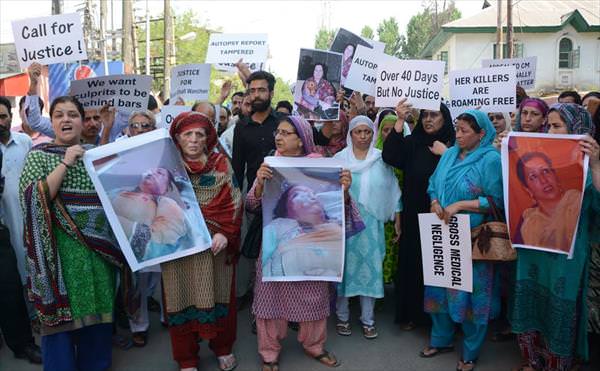Turbulent April is over. There are speculations of what might come ahead for the rest of the year. Talks, pellets, meets, internet ban and militancy all make it to the front pages of leading local dailies. Buried inside the papers, there often appear desperate cries for attention.
Also Read: The Internet Ban In Kashmir Is A Clear Violation Of Human Rights And No One Seems To Care
A 3×2″ box in most dailies on April 29 carried news of a woman committing suicide in Anantnag district of Jammu & Kashmir. On April 15, another set herself ablaze in Kangan. Earlier this month, a young HDFC bank employee gave up her life to the harassment faced at the hands of her boss.
Coming month will mark the death anniversary of a young school teacher, Saiqa Wanchoo who was also allegedly poisoned by her in-laws last year and 17 year old Romana Javaid, crushed to death by two street harassers eight years ago. In April, another woman was close to becoming Wanchoo when her husband tried to set her on fire. She is now recovering from her injuries.
In all these cases, the murderer was known to the victim and visible and recognizable to the society. Yet the response largely is silence.
There can’t be a single reason for what’s killing Kashmiri women. There is a class of people who attribute everything to the ongoing conflict in the state and there is a group of people who attribute it to modernization. And then there are those who attempt to understand the problem and dismantle its binaries.
Conflict certainly affects every part of our daily lives with simple things becoming unnecessarily frustratingly complicated. Accessing internet for example. You always have to be ready with the backup connections and also do a comprehensive study on breaching security to use Google search engines.
How the conflict dictates torturing women to death is not discernible to me. However, how the conflict annihilates discussion and a call for action against this cruelty is understandable. Being politically relevant in a conflict zone adds value to ones life and death. A young Kashmiri actress meeting the Chief Minister Mehbooba Mufti becomes a larger issue than than all these women losing their lives.
The former was said to be a political statement hence gathered many responses while the latter, unfortunately apolitical, was met with silence. No social media storms, no hartals, no demonstrations, no state defense and no prime-time debates either. No TV anchors and no Kashmiri panelists arguing to address this issue. And no recognition of the problem altogether.
the conflict annihilates discussion and a call for action against violence against women.
Any incident, no matter how remotely political can also converge political rivals to a singular point. Both Yasin Malik, the Chairman of Jammu Kashmir Liberation Front (JKLF) and the Chief Minister Mehbooba Mufti went to meet the college girl injured in student protests recently. The girl could not recall whether the stone that hit her had come from a CRPF camp or been hit by the protesting male stone pelters, making it a win-win situation for both. Neither wanted to miss the opportunity to score brownie points before media when all the media attention remained fixated on that girl.
The bitter truth is that the discourse on issue of violence against women catches up depending upon its political relevance and the perpetrator.
How many leaders are expected to visit the families of the women who committed suicide or were killed by in-laws?
The bitter truth is that the discourse on issue of violence against women catches up depending upon its political relevance and the perpetrator. What keeps the incidents of state violence against women alive in people’s memories is the follow up by the groups defending the cases, the NGOs, the media. The unnamed Anantnag and Kupwara women will forever remain unnamed.
The FIR has been logged says police. The investigations will follow. But will the media, people and other groups?
With no intention of belittling any struggles, I believe Saiqa, Romana and other unnamed women who lost their lives to those around them deserve similar commemorations as that of victims of state violence. There is a need for protesting these crimes irrespective of perpetrator or time and place and irrespective of the political allegiance of a person.
The stories never conclude with lives ending, neither they should. They ought to serve as markers for what we don’t want to see in our society. Just as we do not want any more Kunan Poshporas, we don’t want anymore women burnt by in-laws or women succumbing to the pressures and killing themselves.
About the author(s)
A teacher and a learner.




